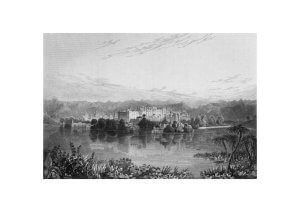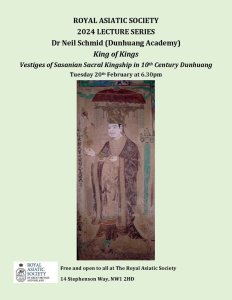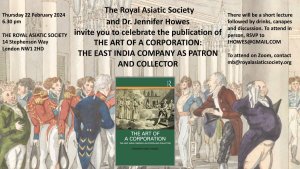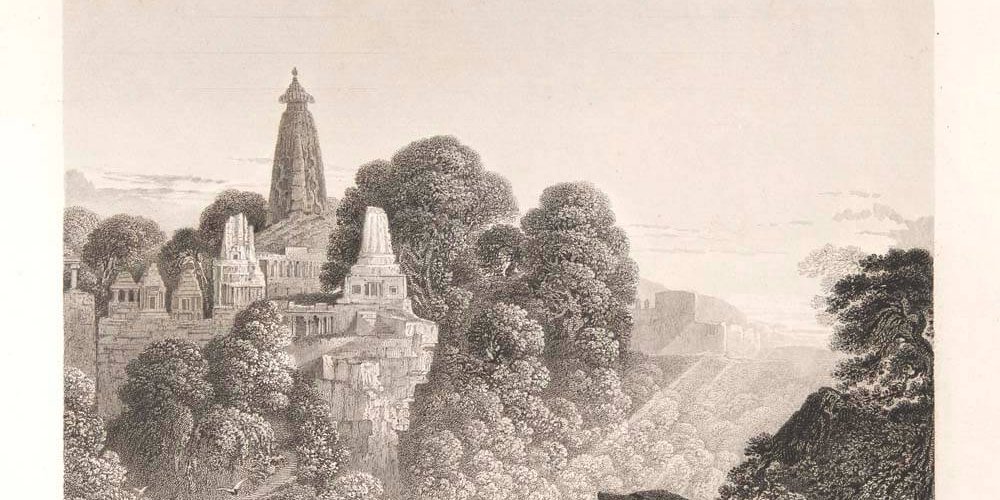Making a Book: The Society’s Anniversary Edition of Tod’s Annals and Antiquities of Rajast’han.
This week’s blog post is provided by Dr Gordon Johnson, Vice-President of the Society:
James Tod’s Annals and Antiquities of Rajast’han or the Central and Western Rajpoot States was published in 2 volumes, the first in 1829 and the second in 1832. The book was dedicated, with permission, to the King, George IV. The two volumes were printed by J L Cox, Great Queen Street, Lincoln’s Inn Fields, and sold in London by Smith, Elder, & Co., 65 Corn-hill, and Calkin & Budd, Booksellers to his Majesty, Pall-Mall.
It was a substantial work. Volume I ran to 840 pages with a frontispiece, map, and 29 other plates distributed throughout the text. Volume II comprised 826 pages with a frontispiece and 22 other plates placed in the text. On publication the two volumes were advertised at £9 guineas, which, according to the Bank of England’s inflation calculator is roughly £945.43 in 2023 values. The original cost could have been as much as 50% higher depending on the binding chosen by the buyer, who could also ask for extra engravings to be included in the finished product.

The book was a remarkable creation. Although the use of Indian scripts in printing was already commonplace in Tod’s time, what was unusual was the inclusion in the Annals of facsimile reproductions both of Indian documents and miniature paintings. The illustrations in the two volumes used a range of techniques, including copperplate engravings, woodcut block prints, and lithographs. Many of these were produced by the leading practitioners of the day, most notably Francis Finden and Mary Byfield.
Tod was a founding Fellow of the Royal Asiatic Society, its first Librarian, and a significant benefactor donating to the Society a large collection of manuscripts, drawings, paintings and other objects. The Society determined to mark its bicentenary in 2023 by, among other activities, honouring Tod’s pioneering scholarship. His book has been reprinted many times in one form or another. In the nineteenth century and twentieth centuries it was translated into Bengali, Marathi, and Urdu. It was taken up by Indian nationalists, including Tagore, Gandhi and Nehru, who took from Tod’s text the notion that India had nationalisms and sovereign states. William Crooke, an ICS Officer, was commissioned to prepare a new edition in the early twentieth century. It was published by OUP in 1920. Crooke was an intrusive editor, distorting the arguments of the original to suit his and his colleagues’ anti-nationalist agenda and he was fulsome in his corrections. Crooke’s version has held sway until now, and has been used as scholarly resource, text book, and the basis for reproduction of Tod’s book for a general or tourist reader. The many (corrupted) edited versions of Tod that exist prompted Dr Norbert Peabody to propose re-issuing the original – the text as Tod wrote it including the plates. An essay in the Companion Volume to the Society’s Anniversary edition explains fully Peabody’s editorial principles and acknowledges the scholarly support he has received from many colleagues – especially from Ramya Sreenivasan and Brian T Cannon – during the seven years of the new edition’s gestation.
What follows records how the book has been made. From the start the Society worked with Yale University Press as co-publisher. The new edition comes as a boxed set of three volumes: Tod’s original work including the plates, plus a Companion Volume of essays, notes, and reproductions of art work, mainly but not exclusively, from the Tod collection held by the Society. A slip-case contains the map and four other fold-out plates from the original. Volume I extends to 564 pages; volume II has 602 pages. The Companion Volume, comprising 532 pages, contains notes, essays and the reproduction of 177 drawings and paintings relevant to the period and subjects Tod covered. The volumes were printed, bound and boxed in Italy by Conti Tipocolor SpA, Florence. Production was overseen by Yale University Press. The new edition was designed and typeset by H2Associates (Cambridge) Ltd.
The first task was to create an electronic copy of the first edition. One set in good condition, originally in the library of the Royal Institution (which had rooms nearby the Society in the 1830s) and owned since the early 1970s by a member of the Society, was chosen for digitisation. In 2016, digital files were created by the Reprographics Department in the University Library at Cambridge, using the most up to date technology. The process was not straightforward because the then Optical Character Recognition System did not recognise all of the typefaces in the text and made substitutions. This meant that the electronic files had to be proof-read letter by letter against the original and corrections made. All images were photographed digitally from the Society’s collection of proof prints from the early nineteenth century. Some images were missing or damaged, so photographs were also taken from three other first edition sources. An amazing level of detail was captured by the professional digital photographic process with included, along with Finden’s original work, much of the tone from the paper on which the originals were printed as well as marks and ruckles in the paper itself. This had to be removed digitally (by H2Associates) using editing tools in Adobe Photoshop. Photoshop also made it possible to sharpen and adjust contrast so that the images would appear as close as possible to the original engravings when printed lithographically. These ‘digital assets’ are now part of the Society’s holdings and available for use by scholars and others wishing to reproduce images in a book or article. Because the files were photographed at greater than fifty percent than the originals it is possible to study them on screen in great detail. A number of hidden details were revealed in the course of this work that receive comment in the Companion Volume. Since all the new work was done on the digital files, the engravings themselves were left untouched
The original printing could not, and was not to be, simply reproduced as facsimile. The book was redesigned, both to reduce its bulk and to make it easier on the eye. A font was chosen to be sympathetic to the original, and a two-column lay-out was used as being more reader-friendly. The body text is set in 10-point Sabon with 3-point leading; chapter synopses in 12-point Myrian Pro Light with 5-point leading. Devanagari is set in Tiro Devanagari Hindi and Tiro Devanagari Sanskrit. No additional notes or corrective material were to be introduced into the Annals themselves, but a discrete crimson crown (drawn from the Society’s emblems, designed by Thomas Daniell RA and his nephew William Daniell RA in 1823) indicate in the text that a note or comment will be found in the Companion Volume. The two Tod volumes are printed on Magana Naural (an uncoated stock); volume 3 with its many reproductions in colour uses Perigord Matt (a coated stock). The Companion Volume is laid out more conventionally, but the challenge here has been to insert the art in such a way as to break up the mass of type and to be relevant to the content of the pages on which the illustrations are placed.
As explained in the Companion Volume (p xvi) “While acknowledging the design of the first edition, the designers have also given a nod to the Rajasthani manuscripts from which much of Tod’s material derived. This is notably evident in the use of red typeface and red symbols at various points throughout the text. Although black ink was generally favoured in the writing of Rajasthani manuscripts, it was common practice to write the opening invocation and the concluding colophons in red ink. Similarly, where the manuscript was in verse, the metre of the verse (which could change every few lines) would typically be specified in red. Beyond this, readers of Rajasthani manuscripts frequently applied vermillion sometimes scented with sandalwood) to the text to indicate particular significant passages (a fragrant version of the European manicule).

“To reflect these practices, the designers have rendered in red the first and last entry of the synopsis that appears at the beginning of each chapter. Similarly, the footnotes of the first edition [in square brackets] appear in red. While Tod’s Annals is a profoundly orientalist text in many ways, the Companion Volume shows that important Rajasthani dimensions also run through it, and that they are too often overlooked. Some of the design features of the reissue are intended to remind the reader that the text is populated by many different voices, including those of Tod’s principal Indian interlocutors.”
A large fine scholarly edition of any book is bound to be expensive and to have a limited market. Initial costs to be found before publication were reckoned to be around £200k. The Society determined that it would seek only to break even on the project. Consultations suggested that a limited print-run of 750 copies might meet the immediate purpose, and prices were fixed at £800 and $1,000. An offer of purchase at £725 paid a year in advance of publication was taken up for 70 copies.
Preparing the electronic files for printing has provided an opportunity for the Society to re-assess the contents of the Tod collection. Conservation and digital work was done, providing the basis for greater accessibility for future research and of mutually beneficial collaborations with institutions in Rajasthan. Tod had copies made of 16th and 17th century texts now otherwise lost; and works he was given or commissioned can now more easily form the basis of new academic study.
More information about this new edition of the Annals can be found on the 2023 Bicentenary page of our website. For anyone wishing to purchase these volumes, they are available from the Yale University Press website.
Next week the Society will host a lecture and a book launch:
On Tuesday 20th February, 6.30 pm, Dr Neil Schmid from the Dunhuang Academy will lecture on King of Kings: Vestiges of Sasanian Sacral Kingship in 10th Century Dunhuang and on Thursday 22nd February, 6.30 pm, Dr Jennifer Howes will celebrate the publication of her book, The Art of a Corporation: The East India Company as Patron and Collector. Both are hybrid events and if you wish to attend via zoom, please contact Matty Bradley (mb@royalasiaticsociety.org). If you wish to attend Jennifer Howes’ event in-person, please let her know at: jhowes@gmail.com



